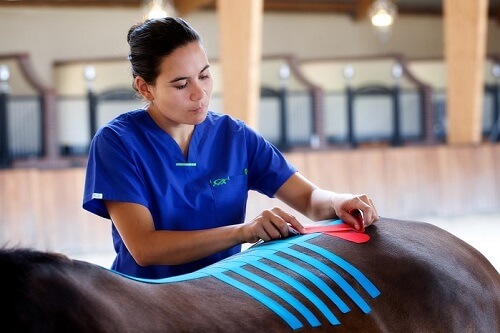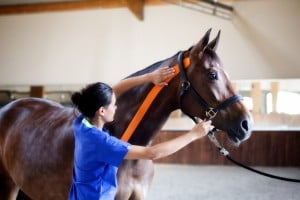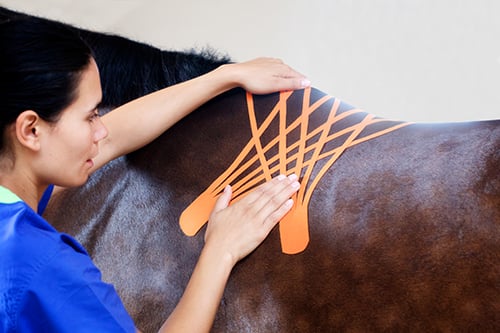VetkinTape offers specialized equine kinesiology taping courses for equine professionals. The courses are developed in cooperation with equine practitioners with a veterinary and physiotherapy background, professionals from the Animal Health industry and VetkinTape.
Equine Taping Course & Certification summary
Each course consists of two days (8 hours each), has a mixture of theory and practice and is organized at venues with enough room for practical exercises. During the courses, the instructors will use video’s, pictures and real-life cases. The courses are accredited in several EU-countries by the local animal physiotherapy associations or vet associations. During these courses a manual, rolls of VetkinTape, scissors and other supporting materials are provided.
- Duration: 2 days, 8 hours per day (plus 2 hours home study)
- Included:
- Official equine therapy certification
- Educational material
- Who:
- Animal physiotherapists,
- Veterinarians,
- Other therapists with suitable anatomy and biomechanical knowledge.

Course feedback
“It where two very interesting and educational course-days. After explaining the concept, functionality and possible applications of kinesiology tape, we practiced taping on eachother, cool! The second (practical tape apply-ing) part of the course contained: the observation of taping, which tapingtechniques to use, techniques for which application and when are the effects noticable.“

Course program
Program
- Introduction
- Theoretical background of the Medical Taping Concept (human & Vet)
- Various application possibilities:
- Activating the blood and lymph circulation for swellings and hematoma
- Influencing the fascia and muscles
- Treatment of scars
- Tendon injuries and inflammations
- (follow-up) Treatment of injuries to the Musculoskeletal System
- Improvement of the muscle function
- Supporting the joint function
- Case histories and applications for horses and humans related to the following effects:
- Injured muscles – to lifts the skin from the underlying tissues. This has an effect of reducing pain, promoting circulation,
- assisting in the reduction of any swelling and enhancing the blood flow to the injured muscle
- Biomechanical dysfunction – to provides support or stability without restricting the range of motion
- Postural dysfunction – to improves the proprioceptive feedback to the area thereby assisting in the retraining of muscles that maintain correct posture
- Pratical approach with cases
Course instructors
Our instructors are equine practitioners with a veterinary and physiotherapy background, specializing in orthopaedics and with extensive taping experience.
Equine kinesiology taping course dates
When: TBA
Where: TBA

Interested in our Equine Taping course?
Contact us! Please provide your Name, City, Telephone number & Email address and we will get back to you as soon as possible.
Course summary
- Duration: 2 days, 8 hours per day (plus 2 hours home study)
- Included:
- Official equine therapy certification
- Educational material
- Who:
- Animal physiotherapists,
- Veterinarians,
- Other therapists with suitable anatomy and biomechanical knowledge.
Attention: We would like to remind you that certain tape applications, provided on our website are not yet fully scientifically proven. Mentioned applications are based on extensive evaluation and case studies with licensed veterinary physiotherapists and/or other veterinary professionals.

